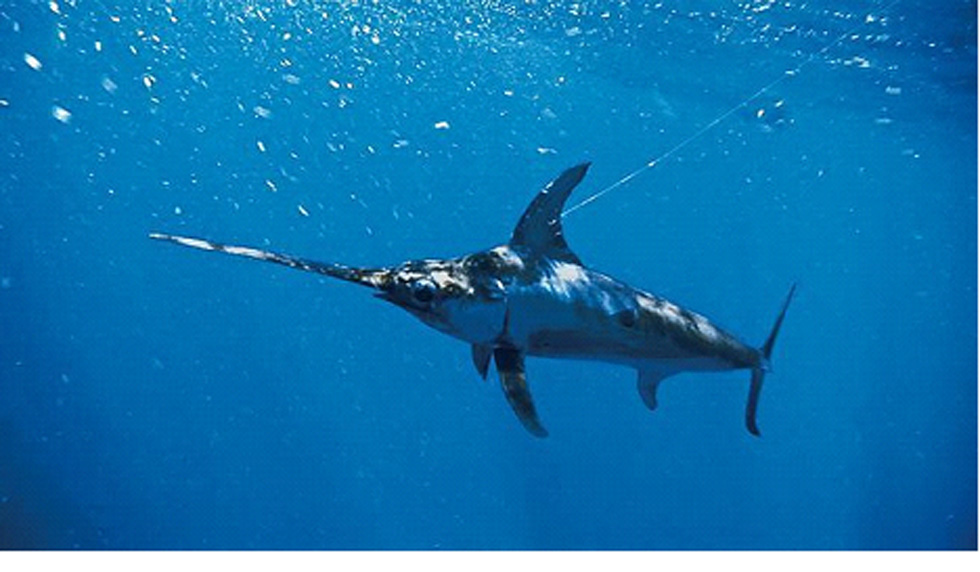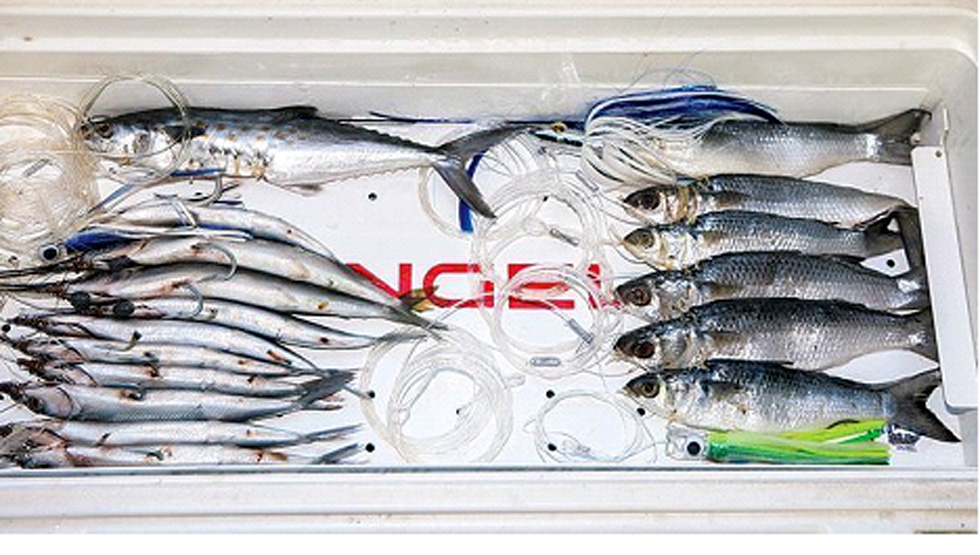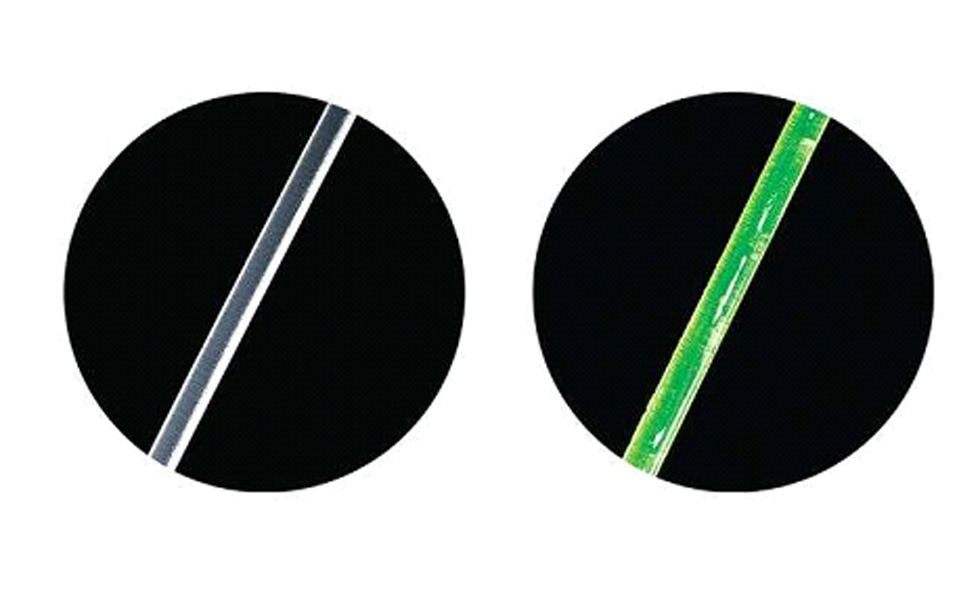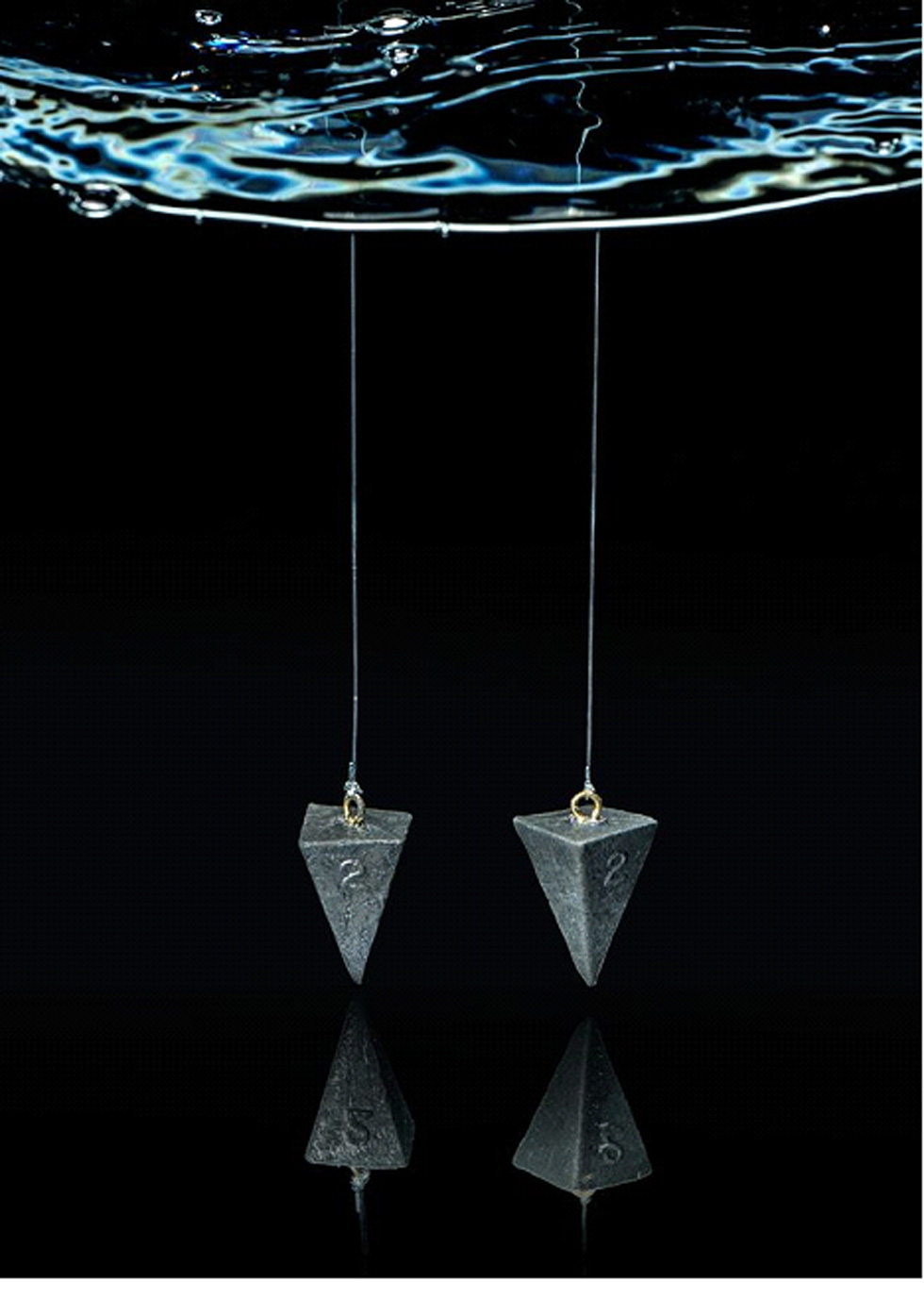|
The refractive index of fluoro is nearly identical to that of water, and its diameter is smaller than nylon mono for the same pound-test; 30-pound fluoro on the left is still less visible underwater than the 20-pound mono on the right.
Jon Whittle
--------------------
Is fluorocarbon worth the extra money over nylon monofilament for leaders? My answer is a resounding yes. It’s a high-performance material that results in more bites and catches. But don’t take my word alone as gospel.
Striper Pro
Tom Daffin specializes in trophy striped bass, tautog and tuna out of Cape May, New Jersey. In fact, at 25 pounds, 4 ounces, the current New Jersey state-record tog was caught aboard his boat, and he has two additional 20-plus-pound togs to his credit. More on his toggin’ in a bit.
When trolling for stripers, Daffin sticks with nylon mono leaders. “As a charter captain, it’s about saving money,” says Daffin. “Plus, it’s not like we’re fishing in clear water here; when our nearshore waters are clear, we have about 8 feet of visibility. Our striped bass aren’t that sensitive to leaders, especially on the troll.”
Daffin generally trolls Mojo lures in pairs, rigged on 100-pound mono leaders on small conventional reels filled with 65-pound braid.
“The heavy mono is extremely durable, and its stretch provides shock absorption. Fluorocarbon doesn’t stretch or absorb shock. On the Mojos, we commonly hook and fight two big bass on one same outfit. There’s a lot of stress when two 30-pound fish oppose each other, and the mono absorbs the stress, resulting in fewer pulled hooks and terminal-tackle failures.”
Mono leaders are also Daffin’s ticket for success when chunking in ¬Delaware Bay. “For a long time we used 60-pound mono leaders, but the dog sharks were problematic,” says Daffin. “Rather than keep losing hooks, we bumped up to 100-pound mono leaders. It solved our cutoff issues, and it didn’t affect our striper bites.”

Fluoro leaders are also more likely to fool sharp-eyed species than mono.
Tuna and Tog
When it comes to tog and tuna, Daffin switches to fluorocarbon. As mentioned earlier, because it has a refractive index nearly identical to water, fluorocarbon is less noticeable and boasts higher abrasion resistance over nylon mono. Therefore, for tuna chunking and plucking big togs, it produces more bites and landed fish.
“Fluoro is necessary for pulling up big togs around wrecks,” says ¬Daffin. “Its tough finish stands up a lot better than mono when dragged over a wreck.” Daffin uses 65-pound braid, then adds a 12- to 15-foot top shot of 60-pound mono for shock absorption, followed by a 12- to 15-inch leader of 60-pound fluorocarbon. “You wouldn’t think togs are leader-sensitive, but I’ve fished both fluoro and mono leaders of the same strength side by side as a test, and the fluoro produced better catch ratios.”
Tough Love
In South Florida and clear, blue Caribbean waters, the choice is all about abrasion resistance for Jeffrey Liederman, a team member aboard the 63-foot Spencer Sand Man. “Yes, the properties of fluorocarbon make it harder for fish to notice it, but we choose it primarily for its superior abrasion resistance,” says Liederman.
“When live-baiting for sailfish, that toughness lets us scale down in leader strength. So, instead of 50-pound leaders, we’re using 40- and even 30-pound leaders. And because the diameter of fluoro is smaller than mono of the same strength, and our leader diameters are further reduced when we scale down, that makes them even more difficult for fish to see.”
Liederman claims they’ve also scaled way down on their marlin leaders. “We’re not interested in long, drawn-out fights, but rather getting to that leader as quickly as we can to score a legal release. So, we’re using a lot of 80- and 100-pound fluorocarbon leaders on our 30-pound stand-up tackle. The smaller-diameter leaders get more bites, and they hold up well due to fluoro¬’s toughness. Plus, with 30-pound-class gear, we’re not putting the heat on a fish that we would with heavier marlin tackle. What’s also neat about these lighter fluorocarbon leaders is that they’re very efficient when there’s a mix of both blue and white marlin.”
Is there a disadvantage to using fluorocarbon for offshore pitch-baiting and trolling? When bait-fishing with circle hooks and 200-plus-pound leaders, Liederman says the stiffness of fluorocarbon could interfere with a successful hookup, if it prevents the circle hook from rolling into the corner of a fish’s mouth as effectively as a more supple mono leader. “But that would be about it,” says Liederman. “It’s all fluoro for our offshore fishing.”

Abrasion resistance makes fluoro better for billfish leaders.
Mono Rally
Mono leaders do have an offshore niche. For instance, a mono leader of 10 to 20 feet is ideal for bailing school dolphin. The suppleness of mono lets the line roll smoothly off the spool and through the guides, promoting casting distances. And when a fish is flipped in the boat, simply remove the hook, cut off any damaged leader portion, retie the hook and cast another bait. With a long leader to work with, there’s no time wasted rerigging shorter leaders.
Old-time yellowtailers still swear by straight monofilament line or mono leaders. Because nylon mono is porous and absorbs water, it has a near-neutral buoyancy. Therefore, it sinks more slowly than fluorocarbon, which does not absorb water. A yellowtail bait on a mono leader drifts at the same rate as the chum. And the more that bait blends in with the chum flow, the more yellowtails it fools.

The most widely promoted ¬advantage of fluorocarbon is its refractive index, which nearly matches that of water. In clear water, sunlight passes through fluoro without refracting. Therefore, no light distortions exposes the leader to alert fish. Yet in many scenarios, water clarity isn’t a factor. And in murky or darker water, fluorocarbon’s biggest overall advantage is abrasion resistance versus that of nylon monofilament of the same breaking strength.
Jon Whittle
Fluorocarbon Leaders: Pros and Cons
Advantages:
• Stiffer than mono
• Minimal stretch
• High abrasion resistance
• Smaller diameter than nylon monofilament of same breaking strength
• Sinks faster than monofilament
Disadvantages:
• More expensive than nylon mono
• Strong memory
• Too stiff to make a good main fishing line
• Needs to be replaced after a quality fish catch because its original properties may have been compromised. After being stressed, it could prove no less visible than a nylon mono leader, and it could be weakened.
Tips
• Before deploying, stretch the leader to remove spool memory so it lies straight.
• Before a bait is redeployed, clean the leader of any film with an alcohol wipe, especially in clear water, when chunking or live-baiting.
• Try dropping down in breaking strength to increase the bites.
Monofilament Leaders: Pros and Cons
Advantages:
• Lower price
• Suppleness makes it easy to handle and cast
• Stretch offers shock absorption
• Lower memory
• Slow sink rate
• Softer and easier to grip
• Durable and long-lasting
Disadvantages:
• Not as low-vis as fluoro
• Stretch can become an issue when fishing light lines or bottomfishing
• Softer finish is prone to nicks and abrasion from fish and structure
• Larger diameters in a given pound-test impede reaching the preferred depths for swimming plugs, deep-tracking lures, and live baits
Tips
• Retie all knots often to guard against wear and preserve the maximum line strength.
• Make sure the shiny leader finish remains intact. When it’s gone, the leader is showing signs of weakening.
• Abstain from using high-vis monofilament for a leader to minimize the potential for refusals from keen-eyed target species.
|





